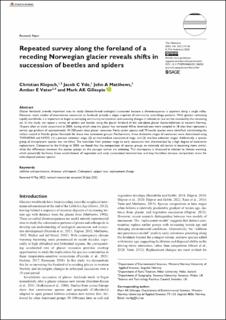| dc.contributor.author | Klopsch, Christian | |
| dc.contributor.author | Yde, Jacob C. | |
| dc.contributor.author | Matthews, John A | |
| dc.contributor.author | Vater, Amber E | |
| dc.contributor.author | Gillespie, Mark Andrew Kusk | |
| dc.date.accessioned | 2023-03-24T13:52:54Z | |
| dc.date.available | 2023-03-24T13:52:54Z | |
| dc.date.created | 2022-11-30T08:19:24Z | |
| dc.date.issued | 2022 | |
| dc.identifier.citation | The Holocene. 2022, 33(1), 14-26. | en_US |
| dc.identifier.issn | 0959-6836 | |
| dc.identifier.uri | https://hdl.handle.net/11250/3060400 | |
| dc.description.abstract | Glacier forelands provide important sites to study climate-forced ecological succession because a chronosequence is apparent along a single valley. However, most studies of invertebrate succession in forelands provide a single snapshot of community assemblage patterns. With glaciers retreating rapidly worldwide, it is important to begin re-surveying community composition and assessing changes in relation to new terrain revealed by the retreating ice. In this study, we repeat a survey of spiders and beetles along the glacier foreland of the sub-alpine glacier Austerdalsbreen in western Norway, 15 years after an initial assessment in 2004, during which time the glacier has retreated 400 m. Invertebrates were sampled in 18 sites that represent a terrain age gradient of approximately 10–250 years since glacier recession. Forty spider species and 70 beetle species were identified, constituting the richest record in Nordic glacier forelands for these two taxonomic groups. Furthermore, three distinctive stages of succession were determined using TWINSPAN and NMDS: (1) a pioneer colonizer stage; (2) an intermediate successional stage; and (3) two late colonizer stages. Additionally, a species group of omnipresent species was identified. The transition from pioneer stage to early succession was characterized by a high degree of taxonomic replacement. Compared to the findings in 2004, we found that the composition of species groups on relatively old terrain is becoming more similar, while the differences between the species groups on the younger terrain are widening. This discrepancy is discussed in relation to climate warming, which potentially facilitates faster establishment of vegetation and early successional invertebrates and may therefore increase competition stress for cold-adapted pioneer species. | en_US |
| dc.language.iso | eng | en_US |
| dc.publisher | Sage Publications | en_US |
| dc.rights | Navngivelse-Ikkekommersiell 4.0 Internasjonal | * |
| dc.rights.uri | http://creativecommons.org/licenses/by-nc/4.0/deed.no | * |
| dc.title | Repeated survey along the foreland of a receding Norwegian glacier reveals shifts in succession of beetles and spiders | en_US |
| dc.type | Peer reviewed | en_US |
| dc.type | Journal article | en_US |
| dc.description.version | publishedVersion | en_US |
| dc.rights.holder | © The Author(s) 2022 | en_US |
| dc.source.pagenumber | 14-26 | en_US |
| dc.source.volume | 33 | en_US |
| dc.source.journal | The Holocene | en_US |
| dc.source.issue | 1 | en_US |
| dc.identifier.doi | 10.1177/09596836221126032 | |
| dc.identifier.cristin | 2084926 | |
| cristin.ispublished | true | |
| cristin.fulltext | original | |
| cristin.qualitycode | 1 | |

